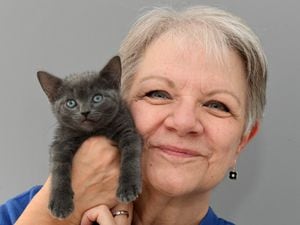Meet the very special guide dogs leading the way
Guide dogs help their sight-impaired owners have independent and safe lives, but what does it take to become one? Weekend find out. . .

They offer true and unconditional companionship – but more importantly another pair of eyes for those who can’t see.
And these specially trained and loyal workers know that when their harness goes on they have a job to do.
Guide dogs provide anyone who is blind or partially sighted with a safe and effective way of getting out and about independently.
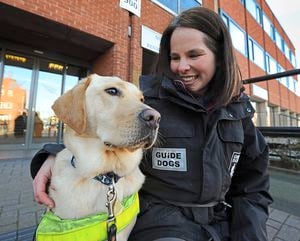
“They make such a difference to their lives. It’s a unique and special bond, the bond between a guide dog and guide dog owner. They rely on each other but at the same time it’s a partnership. They are in it together,” explains guide dog mobility instructor Lucy Michaliszyn.
There are currently around 5,000 working guide dogs helping their owners every day across the UK – including just under 240 in the Black Country, Staffordshire and Shropshire.
Weekend visited Guide Dogs’ Shrewsbury mobility team to find out more about these special canine helpers.
Every dog starts their journey at the charity’s National Breeding Centre, located just outside Leamington Spa, where there’s capacity to breed up to 1,500 puppies a year.
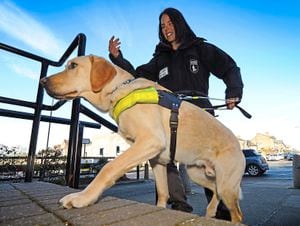
Labradors, golden retrievers and German shepherds have been, and remain, the most common pure breeds on the programme.
But historically the golden retriever crossed with the Labrador has produced the most successful guide dog of all, combining many of the great traits of both breeds.
Puppies may be born at the centre or at home with volunteer carers where they are introduced to everyday sights and sounds found in the home, such as vacuum cleaners, televisions, radios, washing machines and various visitors.
At the age of six weeks, they start their initial training with a puppy walker, who plays a vital role in their early socialisation and education.
The aim of this stage is to produce a puppy that is socially well-behaved, friendly and responsive to the handler.

They are taught to walk ahead on the lead and obey simple commands such as sit, down, stay and come. The puppies are introduced to different sights, smells and sounds – such as busy roads and public transport – and they also attend classes to learn how to behave properly around other people and dogs.
When the puppy is between 12 and 14-months-old, they are ready to start their equivalent of primary school and will be looked after by a boarder during evenings and weekends. Guide Dogs has four training schools which are in Forfar, Redbridge, Leamington and Atherton.
Here they undertake 16 weeks of basic training during which they wear a brown harness and learn to walk in a straight line unless there’s an obstacle, not to turn corners unless told to do so, to stop at kerbs and wait for the command to cross or turn left or right. They also learn to judge height and width so that their owner does not bump their head or shoulder and to get used to traffic.
Once they have finished this stage, next up is secondary school for their advanced training where mobility instructors, like Lucy, help them to apply their guiding skills to everyday situations.
Lucy says a common misconception is the belief that guide dogs are in someway different when they are born to other canines but she says it’s all down to the training, rather than genetics.
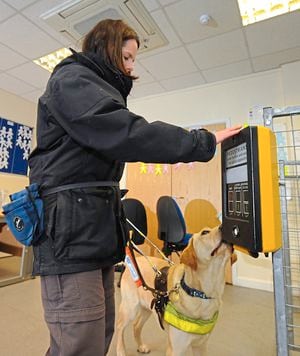
“A lot of people assume they are born like it and that they are a bit robotic but they are completely normal dogs and will do normal dogs things like chasing cats and barking.
“But we invest time in their training and the socialising that the puppy walkers do to make sure they are calm, friendly and will respond well to the different commands we need them to learn.
“We do get dogs that don’t make the grade and that can be for a variety of reasons.
“We had one dog that suffered from body sensitivity and she didn’t like it when the harness was fitted, it made her anxious.
“It’s imperative that they are not bothered by the harness and we need it to become second nature to them to wear it,” says Lucy, who studied animal behaviour at the University of Lincoln.
One of the dogs currently being put through his paces by Lucy is 20-month-old yellow Labrador Kelsey.
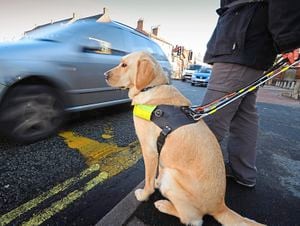
“He’s a great dog – he’s really high on life. He is really confident when we go out and about and he can be excited when he says ‘hello’ to other dogs and people.
“All of the dogs I work with have different characteristics and I love their individual personalities. I love how unique the dogs are, you never get two dogs that are the same,” says the 31-year-old, who lives in Bayston Hill, Shrewsbury.
“I make sure they are confident in all situations and respond well to what I am asking them to do. There is a lot of repetition because we will continue to do something until they can get it right every time.
“We use positive reward training – the dogs come to school with their packed lunch and they get the chance to earn some of their food. It’s not about telling them not what to do but about encouraging them to do what we want them to do,” she says.
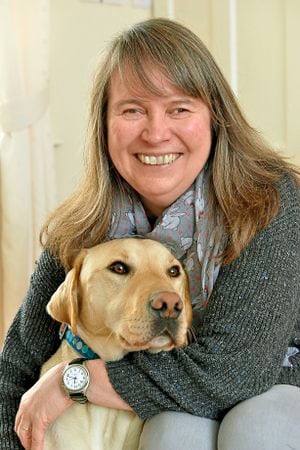
One of the training methods involves a small platform and the dog is trained to go to the platform ignoring whatever distractions there may be such as other dogs or food.
Once they are standing on the middle of the platform, having successfully taken no notice of what else is going on around them, they receive their reward.
This is one of the ways dogs are trained to guide their owners safely to kerbs and the top of steps.
Once a dog has successfully completed 10 weeks of advanced training, they are matched with someone from the waiting list. To do this mobility instructors have to consider the length of the owner’s stride, their height and also their lifestyle.
“We consider things like how quickly the dog walks and how active they are.
“We also consider why someone wants a guide dog, it might be an elderly lady who just wants to go to the Post Office or it might be a student who is going to be out of the house for longer and travelling further. They will require different dogs with a different temperament.
“We will make a recommendation of who we think is the best match,” explains Lucy.
There is no lower or upper age limit for owning a guide dog and they do not need to have lost all their remaining sight.
Waiting times can vary but the charity aims to be training a new owner with a dog within nine months.
Once they are matched the owner and guide dog will then train together for four weeks with the help of Lucy or another instructor from one of the charity’s 20 mobility centres across the country.
They will practice the techniques they will need and gain experience working with their dog successfully in a variety of environments and everyday situations.
It is also an important time for a new owner to build the bond with the dog so that it takes responsibility for guiding them.
If successful, the owner hands over 50p and their new four-legged friend is awarded with a white harness and their working partnership begins. A guide dog will normally work for around eight years before they retire.
They will receive regular visits from a mobility instructor so they can get any additional guidance they might need throughout their time together.
“I love working with guide dog owners – it’s really rewarding. I think the best moment is 12 months down the line when you see what a change having a guide dog has made.
“The person may not have been able to leave the house on their own at all before they had a guide dog but now they feel confident to go out as much as they want because they have their dog at their side. It really is life-changing,” says Lucy.
One owner who would agree is Lin Stapely who lives in Oswestry with her current guide dog – a three-year-old labrador-golden retriever cross named Declan and her 10-year-old retired Labrador guide dog Woody.
Lin, who is registered blind but does have a little sight, first got Woody in 2009 after she was finding it more difficult to get around. “I started to realise I was causing a lot of worry for my family especially my daughter, I knew she was going to school worrying about what I was getting up to.
“I was not wanting to go out on my own anymore. If I did go into town and people were coming towards me I would stand still until they had passed me because I couldn’t judge how far they were away.
“Trips were getting more difficult and because I was having to concentrate so hard, I would get home and be exhausted. It was very stressful and not pleasant. But I got Woody and all that changed.” says Lin.
Woody, who retired at the age of nine, helped to boost her confidence and encouraged her to leave the house.
“He could see things I couldn’t see. I see things as flat but he could judge how far things are away and depth and can guide me around any obstacles. It made a big difference,” explains Lin, who is able to make regular visits to see friends and family and go shopping with her guide dog.
She was given Declan almost a year ago and says they have bonded well.
“He can be mischievous. He’s a very independent dog where as Woody is very needy and wants to be with you,” says Lin.
“Declan is a really good worker and a clever little dog. He picks things up very quickly. I would say he’s pretty much bomb-proof – nothing much fazes him.”





